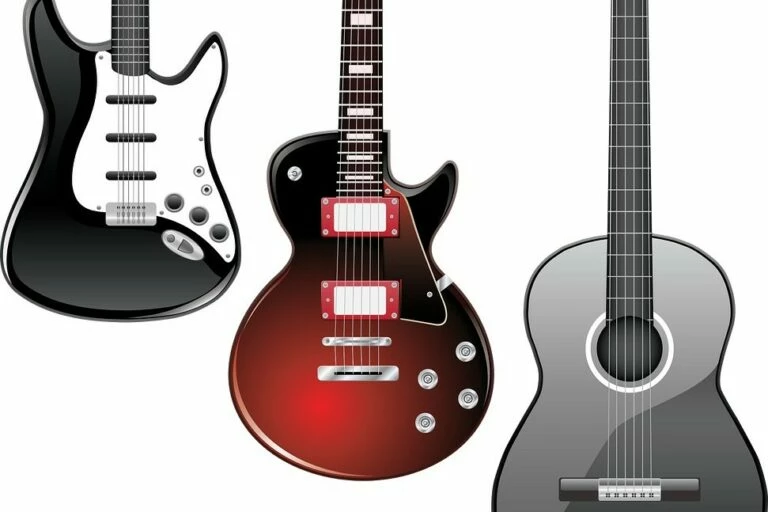Guitars are one of the most popular musical instruments in the world. These stringed instruments typically have six strings and are played with both hands. They are held against the body and are either supported by a strap over the player’s shoulder or rest upon the thigh (usually sitting down).
Broadly, guitar types can be divided into acoustic and electric guitars. There are several dozen types of guitars in each category, but we’ll be restricting our discussion to the following 11 guitars:
- Classical Guitars
- Flat-Top Guitars
- Acoustic Bass Guitars
- Acoustic-Electric Guitar
- Steel Guitar
- 6-String Electric Guitar
- Electric Bass Guitar
- Semi-Acoustic Guitar
- Archtop Guitar
- Twelve String Guitar
- Resonator Guitar[/su_note]
Acoustic guitars have a soundboard (the top) that resonates with the strings when the strings are plucked or strummed. The resonance is transmitted to the hollow body that acts as a sound chamber or sound box which produces the sound.
On the other hand, electric guitars usually have a solid body with no resonating chamber. And when the strings are strummed, the vibration is picked by the pickup and converted into an electrical signal, which is then amplified by the amp to produce a sound.
In this article, we are going to take a look at several different types of each kind of guitars. Some are less popular than others, but it doesn’t hurt to learn about them!
Types of Acoustic Guitars
Acoustic guitars depend on the guitar’s body to produce sound and have a unique timbre with more overtones, natural reverb, and better harmonics than electric guitars.
The body, including the top or soundboard, is made of sheets of wood and plays a significant part in the guitar’s overall sound. The vibrational energy is transferred to the soundboard through the bridge when the strings vibrate. This makes the soundboard and the air enclosed inside the sound chamber or the body vibrate. The resonating chamber or the sound box has a round hole through which the projected sound comes out.
In essence, the acoustic guitar’s body prevents the strings’ vibrational energy from getting lost in the air and converts most of it into sound. However, this cannot be called amplification in the truest sense.
Classical Guitars
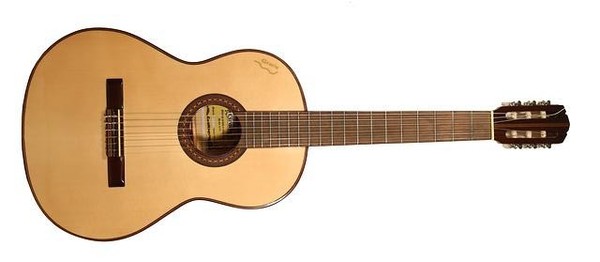
Primarily used in classical music, classical guitars are the modern version of the original guitar. Antonio Torres Jurado, a Spanish luthier, is accredited for establishing the design of classical guitars that remains unchanged for the most part. Classical guitars derive from similar Spanish stringed instruments and are therefore also called Spanish guitars.
Classical guitars originally used to have strings made of gut but nowadays mostly use nylon strings. The three low strings are wound, like in almost all guitars, and copper string is usually used for winding. Nylon strings exert much less tension on the guitar body than steel strings; therefore, many classical guitars may lack a truss rod.
Also, due to the less tension in the strings, classical guitars are easier to press down on the fretboard than steel strings, making them an easier choice for people to get started with. Classical guitars also come in smaller sizes, and the ease of fretting the strings and a smaller body make them an excellent choice for kids interested in learning guitar.
Flat-Top Guitars (or Standard Steel String Acoustic Guitar)
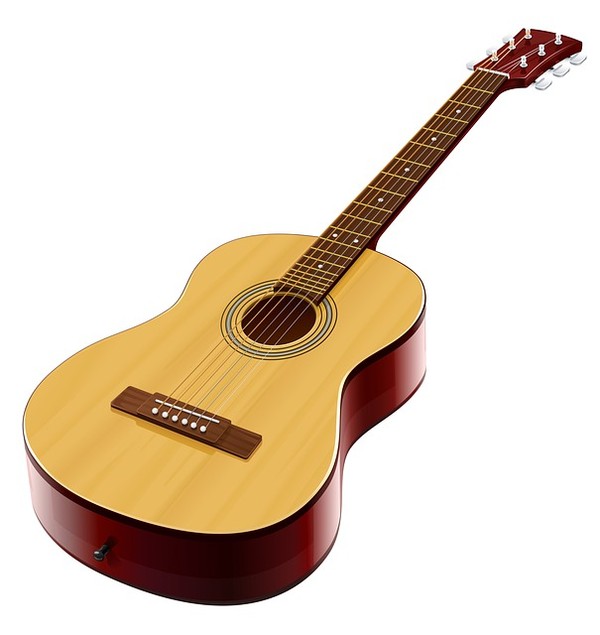
Steel-string guitars are known for their brighter and louder sound. They are also called flat-top guitars because they have a flat top. This distinction is made to separate them from guitars having an arched top (archtop guitars). Steel-string guitars are the most popular and common type of acoustic guitar and are commonly just called acoustic guitars.
The design and build of flat-top steel-string guitars are similar to classical guitars but strung with steel strings. However, the steel strings are in a lot more tension than nylon strings. Therefore, the body has stronger bracing which keeps the hollow body from falling apart from the tension. These guitars almost always have a truss rod that provides a counterforce against the strings and keeps the neck from bending.
A microphone or a piezoelectric (as opposed to magnetic pickups in electric guitars) may be used to amplify an acoustic guitar’s sound when used in performance settings.
Acoustic Bass Guitars
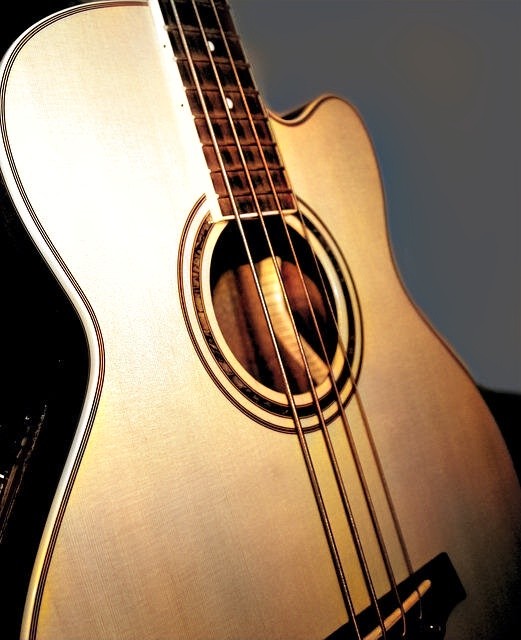
Bass guitars are the lower (in pitch) sounding member of the guitar family with 4 strings tuned to E-A-D-G. The tuning is the same as the 4 lower strings of a regular 6 string guitar but is an octave below. Most bass guitars are electric guitars, but an acoustic version also exists.
Acoustic bass guitars have a hollow body similar to but bigger than an acoustic guitar. This is essential for producing the lower end frequencies with enough volume. Even with a bigger sound chamber, most people amplify the sound of acoustic bass through a bass amp, even in smaller gig settings, as they are hard to hear.
Most acoustic bass also come fitted with pickups for amplification; typically, only the much-bigger Mexican acoustic bass can be heard without external electronic amplification.
They are a niche instrument with a different tone than electric bass guitars.
Acoustic-Electric Guitar
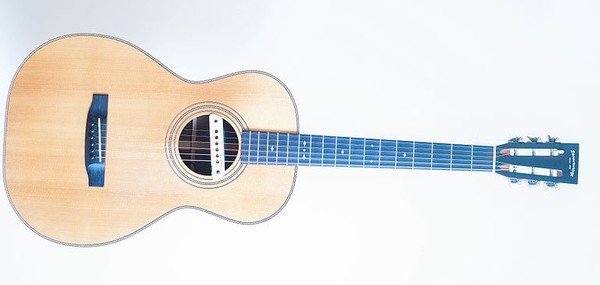
Acoustic-electric guitars are used in place of acoustic guitars in live performances or concerts where a louder volume of an acoustic guitar is required. These guitars use a microphone or piezoelectric pickups fitted inside the sound hole to produce signals from the sound.
Most acoustic-electrics have a preamp onboard, typically with volume, tone and EQ settings. The output from the preamp is sent to the amp or PA system, which produces the sound.
The one downside of acoustic-electric guitars is the feedback issue, which, to some extent, is reduced by the preamp. They also use a different type of amplifier or amp than electric guitars, which keeps as much of the original acoustic tone intact.
Steel Guitar

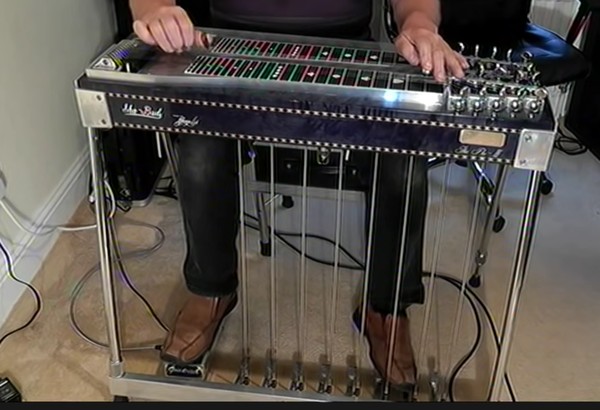
Steel guitars are much different from most other guitar types in both appearance and playing style. Steel guitars have varying types, including small ukulele-like instruments often played placed on the lap (called lap steel guitars). And large table-like instruments that do not look much like usual guitars.
They get their name from the steel bar used to fret the strings instead of fingers; typically, all the strings are pressed at once, like in a barre chord. The strings are plucked rather than strummed.
One of the features of these guitars is the ability to slide between notes with the steel bar smoothly. This enables them to produce a peculiar, almost singer-like deep vibrato sound.
Some artists use these guitars in the country, blues, and rock music genres.
Types of Electric Guitars
Electric guitars depend on the pickups to transform the strings’ vibration into electrical signals. Most electric guitars use a magnetic pickup which needs the strings to be made of ferrous material like steel to induce a signal. The minuscule signal is then sent to the amp that amplifies and produces the sound.
Electric guitars are rarely used without any effects, and even a basic amp provides many options to shape the tone. Effects like distortion and overdrive are prevalent and are almost a part of some genres like rock and metal music. Hundreds of effect units are available and used by musicians to produce a sound that they like and that suits their music.
Electric guitar’s solid-body design with no sound chamber produces minimal sound on its own without being plugged into an amp.
6-String Electric Guitar
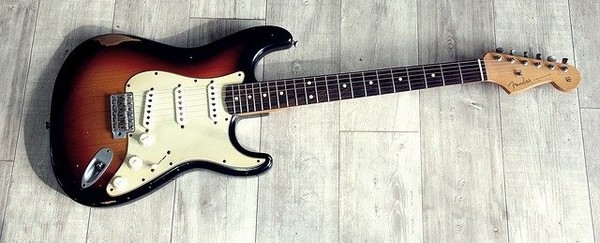
This is the most common type of electric guitar, having 6 strings and a solid body made of wood. The strings are usually made of steel and may have a coating. The strings are less also thick than their acoustic guitar counterparts and closer to the fretboard requiring less pressure from the fingers to play a crisp note (or chord).
This makes the electric guitar easier for beginners than a steel-string acoustic guitar. However, the downside is you need extra gear like an amp to get the best out of an electric guitar.
The unique metallic sound and effects such as distortions, sustain, reverb, etc. make them a favorite among many genres, including rock, metal, and blues.
Electric Bass Guitar
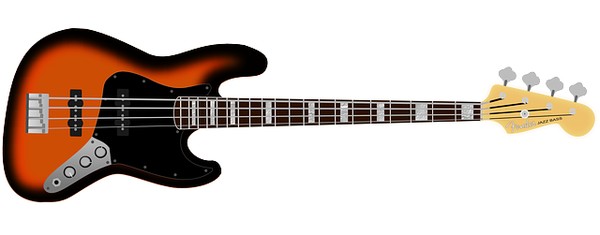
The term “bass guitar” usually refers to electric bass guitars, which is what are used in live performances and songs as a bass instrument.
A typical bass guitar has 4 strings and is tuned to E-A-D-G, the same tuning as the lower four 4 strings of a standard guitar but an octave lower. The tuning is also the same in acoustic bass guitars.
Bass guitars have a considerably longer neck than electric guitars and have much thicker strings. The fretboard is as wide or even wider than in electric guitars. With only 4 strings, the string spacing is consequently much larger.
Semi-Acoustic Guitar
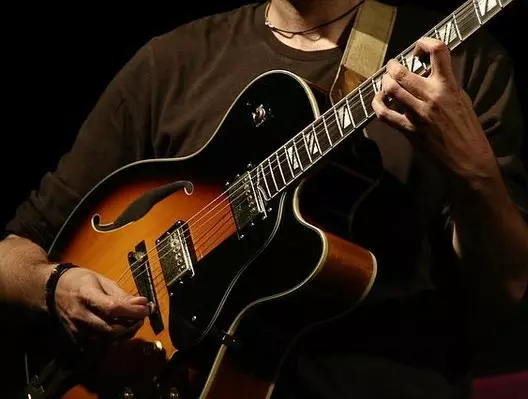
It is a type of electric guitar with a hollow body instead of a full-solid body. The body can be semi-hollow, in which case there is a small sound chamber or full-hollow. Full-hollow body semi-acoustic guitars have an acoustic guitar-like sound chamber but are usually not as deep.
Semi-acoustic guitars usually have f-holes like violins instead of a round hole on the guitar’s top. These guitars have a distinctly warm and clean tone compared to electric guitars and are used by some musicians in various genres, mostly jazz and blues.
Semi-acoustic guitars are fairly audible even when played unplugged and may be a good choice for beginners aspiring to learn electric guitar. These guitars use magnetic pickups like an electric guitar but may suffer from feedback issues.
Other Guitar Types
Besides the guitar types discussed above, there are also several more types worldwide.
Archtop Guitar

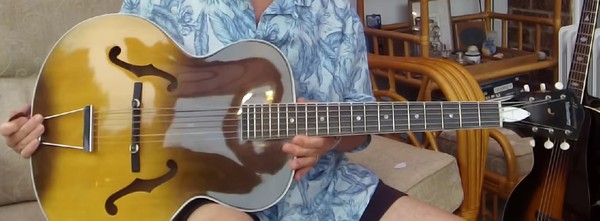
It is a type of hollow-body semi-acoustic or acoustic guitar with an arched top and back that gives it the name, though acoustic archtop guitars are rare. These guitars look similar to hollow-body semi-acoustic guitars and have a very similar construction, including the rear-mounted stop-tail bridge and f-holes.
The arched top or the guitar’s soundboard is either carved out of solid wood or heat-pressing a sheet of wood. These guitars use thicker gauge strings than semi-acoustic or electric guitars. Because of this, they can produce a relatively higher sound volume without being connected to an amp.
Archtop guitars have a mellow sound with more mid-lows and are loved by some musicians, particularly in jazz.
Twelve-String Guitar
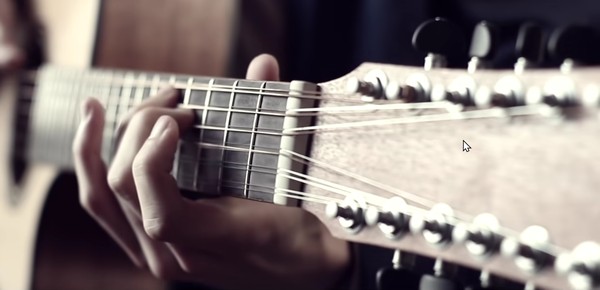
As the name suggests, these guitars have 12 strings instead of 6, but in courses. This means each string has another string in pairs, and both strings are usually fretted and plucked together.
The extra string provides more harmonics and resonance than a regular guitar, making these guitars able to produce a remarkable chorus-like sound effect.
The headstock of 12-string guitars is larger and includes 6 additional tuners for the extra strings. These guitars are available in both acoustic and electric versions and use steel strings. Typically, a 12-string guitar is played much like a standard guitar, with the same fretting and plucking techniques. Therefore, a guitarist can often start playing these guitars with little practice.
The lower four strings have the secondary string tuned an octave apart while the higher two strings are tuned the same.
Resonator Guitar
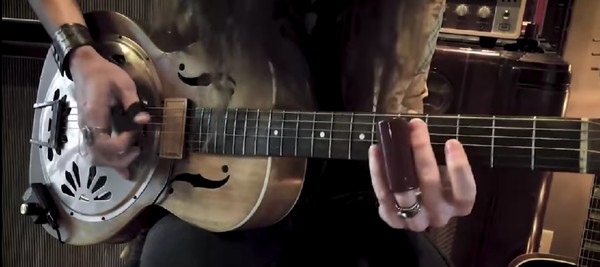
These are a type of acoustic guitar that uses a special cone, like a speaker cone but instead made of metal to produce the sound. The guitar’s bridge transfers the vibrational energy to the cones instead of the soundboard or the top. The cone, along with the hollow body, produces a sound which is often louder than acoustic guitars and with a very bright tone.
These guitars are often made of steel, have f-shape sound holes, and are generally played using different techniques. They may be played in the lap-steel style utilising a steel bar for fretting.
Resonator guitars are also available in the electric variety and are mostly used in the blues and country genres. Musicians may also use a different tuning like Open G or Open D, especially in bluegrass music.
Final Thoughts
Guitars are one of the most famous musical instruments, and it’s no wonder there are dozens of different types of guitars in the world. In this article, we have listed 11 of the more popular types of guitar.
Out of these, the acoustic, the electric and the electric bass are three of the most popular types of guitar. For someone starting out with learning guitars, a nylon string classical guitar or an electric guitar would be a good choice as far as ease of playing is concerned. A semi-acoustic could also be a good contender as it can be played without an amp while still having a decent sound output.
Photo credits:
- Acoustic-Electric Guitar by Karl Thomas Moore, CC BY-SA 4.0, via Wikimedia Commons
- Archtop Guitar by Silly Moustache
- Console Steel Guitar by Tony Browne
- Resonator Guitar by Justin Johnson
- Lap Steel Guitar by Doug Beaumier
- Twelve String Guitar by Eiro Nareth

